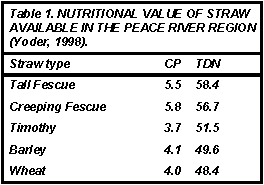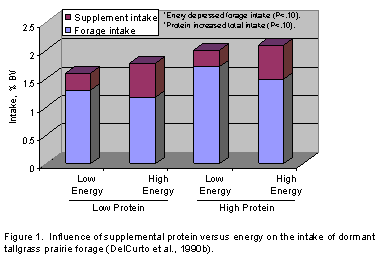| | Supplementation of low-quality roughages | Summary | Literature cited
Beef cattle producers in the Western US and Canada compete at an economic disadvantage relative to other regions in North America due to high winter feed costs. Many producers currently feed 1.5 to 2.5 tons of hay to their mature cows during the winter feeding period. This represents costs of 30 to 50% of the gross revenues from the production of one cow per year. Obviously, our ability to compete with other regions of North America may relate to how effective we can reduce winter feed costs, yet still maintain acceptable levels of beef cattle production.
There are numerous strategies producers may take to reduce winter feed costs. Some of these include utilizing stockpiled forage, planting crops specific for winter grazing and utilizing crop bi-products such as straw in leu of traditional winter feeds. This paper evaluates the use of crop aftermath from the grass seed industry as feed resources for wintering livestock.
Currently, Oregon's Grass Seed Industry produces over 1 million tons of crop residues. Likewise, the Peace River Region of Alberta has a rapidly growing Grass Seed Industry that produces, as a bi-product, straws that have potential as livestock feed. For both areas, many of these grass species are perennial forages (Kentucky bluegrass, tall fescue, fine fescue, perennial ryegrass, bentgrass, etc.. ) and, as a result, are substantially better than annual cereal grain straws (Table 1). In addition, grass seed crops intended for turf crops often yield higher quality straws than forage seed crops.

In most cases, however, grass seed residues should not be considered a complete feed for wintering mature beef cows. Instead, grass seed straws should be tested and supplements formulated to meet the cows nutritional requirements yet maximize the use of the low-quality roughage. Other potential treatments for the use of perennial seed crop straw include use of anhydrous ammonia (ammoniation), chopping, and pelleting. For more thorough reviews of grass seed residues and associated supplementation, refer to DelCurto et al., 2000; Chamberlain and DelCurto (1991); and Turner et al., 1995.
Supplementation of Low-Quality Roughages
In general, when low-quality roughages are not limited in quantity, protein is the most beneficial supplement. Responses to supplemental protein are usually observed when the crude protein (CP) content of the basal forage is less than 6 to 8%. However, several other factors also need to be considered. First, as the digestibility of the forage declines, the availability of the CP to the microbial population and the host animal also declines. The availability of essential nutrients may also impact perceived responses to supplemental protein. Sulfur to nitrogen ratios have a significant role in supplemental protein influences on the intake and indigestibility of low-quality roughages. Likewise, if forage availability is limited, responses to supplemental protein are often not observed because of the animal's inability to express increased intake. In addition, stage of production and/or growth requirements also influence response to supplemental protein. Young growing animals, as well as high production ruminants display a greater magnitude response to CP on similar basal forage, and display responses with higher quality basal diets. Therefore, forage availability, digestibility, stage/production requirements, other limiting nutrients, as well as, the CP content of the forage must be considered when predicting performance responses to supplemental protein.
Protein supplementation response
Numerous researchers have observed increases in beef cattle performance with the addition of supplemental protein to high fiber, low-quality rouphage diets. With mature cows, the benefits are often observed as decreased loss in body weight and condition during the winter feeding or grazing period (DelCurto et al., 1990a; Horney et al., 1996). Adequate maintenance of cow body weight and condition, in turn, tends to promote greater reproductive efficiency and calf weaning weights.
Energy supplementation
In contrast to protein supplements, energy supplements have been reported to depress both the intake and digestibility of low-quality forage. Supplementing low-quality native grass hay, Chase and Hibberd (1987) reported a linear decrease in forage intake with increasing quantities of corn. Energy supplements tend to replace or substitute for the intake of low-quality forages. As a result, energy supplementation of low-quality forage often exerts little or no influence on beef cattle performance (Clanton and Zimmerman, 1970; DelCurto et al., 1990).

Energy supplementation should be discouraged if your goal is to optimize beef cattle performance while utilizing high-fiber, low-quality roughage. However, if the availability of the low-quality forage is limiting, energy supplementation becomes a viable alternative.
Protein to energy ratios
Some consideration of the supplemental protein to energy ratios is warranted. In a series of studies evaluating yearling heifer gains as influenced by supplemental protein versus energy, Clanton and Zimmerman (1970) reported variable results from year to year. In year 1, heifer gain was increased with the addition of supplemental protein but was unaffected by supplemental energy. In year 2, a protein by energy interaction was observed with the addition of energy at low protein levels depressing heifer gain, whereas, energy addition at the high levels of protein increased gain. In digestion studies, increasing energy at low levels of supplemental protein has been observed to decrease low-quality roughage intake and digestibility. At high levels of supplemental protein, increasing energy typically has little effect on intake and digestibility of the low-quality roughage (DelCurto et al., 1990b; Figure 1).
Physical form of supplemental protein
There is limited information available in terms of the efficacy of various types of feed sources that might be used as supplemental protein sources. The most common supplemental protein feed sources are derived from oilseed byproducts such as soybean meal and cottonseed meal. These feed sources, however are at times expensive and, as a result, identifying inexpensive alternative feed sources to provide supplemental protein would be beneficial to ruminant livestock producers.
In the Pacific Northwest and intermountain west, alfalfa hay and/or cubes is often the supplement of choice because of competitive prices and accessibility of the supplements. Studies comparing alfalfa and alfalfa products to oilseed supplements have yielded variable results but, in general, suggest that alfalfa provides the same benefits when presented on a equal protein basis. Other potential supplements include whole soybeans (Albro et al., 1993), wheat middlings (Sunvold et al., 1991), canola meal and high-quality meadow hay (Horney et al., 1996).
The relative successes of the numerous supplements described above illustrate the value of supplemental protein with beef cattle consuming low-quality nitrogen-deficient diets. However, the general success of these supplements suggest that degradability of protein (ruminal versus bypass) is not a major consideration with mature nonlactating beef cattle.
Summary
Beef cattle producers in winter environments that necessitate the feeding of harvested forage are at a competitive disadvantage with other regions of North America such as the Southern US and Mexico. Reducing the costs of traditional winter management by utilizing crop residues such as grass seed straws will be important in future. Although, higher in quality than cereal grain straws, grass seed straws still need some nutritional enhancement such as chopping, grinding, pelleting and supplementation. Supplementation strategies should focus on meeting the protein needs of the animal first. Producers will have to evaluate which protein supplements are most economically viable in their region, as well as which strategy best fits their needs, nutritional calendar and management style.
Some grass species and varieties within species contain endophytes that, in turn, produce alkaloids that may be harmful if consumed by livestock. While the risk to mature nonlactating beef cattle is minimal, some precautions should be taken to reduce the potential of toxicity. First, if you have purchased a variety with a known endophyte infestation level, consider having the straw tested for alkaloid concentrations. Oregon State University can test for alkaloids in grass seed straw. Send samples to:
139 Oak Creek Building
Endophyte Service Laboratory
College of Agricultural Science
Oregon State University
Corvallis, Oregon 97331
Ph: (541) 737-2872
Oregon State University Website
In addition, always balance the rations to meet the animals' nutritional demands and dilute the straws with other roughages when you have concerns related to endophyte-produced alkaloids.
Additional research is needed, however, to fully evaluate alkaloids and feeding cattle in cold winter environments.
Literature Cited
Albro, J. D., D. W. Weber and T. DelCurto. 1993. Comparison of whole raw soybeans, extruded soybeans or soybean meal/barley on digestive characteristics and performance of weaned beef steers consuming mature grass hay. J. Anim. Sci. 71:26.
Chamberlain, D. and T. DelCurto. 1991. Use of grass seed residues as a winter feed resource for beef cattle. Eastern Oregon Agric. Res. Center Circ. of Info. No. 2.
Chase, C. C. and C. A. Hibberd. 1987. Utilization of low-quality native grass hay by beef cows fed increasing quantities of corn grain. J. Anim. Sci. 65:557.
Clanton, D. C. and D. R. Zimmerman. 1970. Symposium on pasture methods for maximum production in beef cattle: Protein and energy requirements for female beef cattle. J. Anim. Sci. 30:122.
DelCurto, T., R. C. Cochran, D. L. Harmon, A. A. Beharka, K. A. Jacques, G. Towne and E. S. Vanzant. 1990b. Supplementation of dormant, tallgrass-prairie forage: I. Influence of varying supplemental protein and(or) energy levels on forage utilization characteristics of beef steers in confinement. J. Anim. Sci. 68:515.
DelCurto, T., R. C. Cochran, L.R. Corah, A. A. Beharka, E.S. Vanzant and D. E. Vanzant. 1990a. Supplementation of dormant, tallgrass-prairie forage. II. Performance and forage utilization characteristics in grazing beef cattle receiveing supplements of different protein concentrations. J. Anim. Sci. 68:532.
Horney, M. R., T. DelCurto, M. M. Stamm, R. K. Barton and S. D. Brandyberry. 1996. Early-vegetative meadow hay versus alfalfa hay as a supplement for cattle consuming low-quality roughages. J. Anim. Sci. 74:1959. Sunvold, G. D., R. C. Cochran and E. S. Vanzant. 1991.
Evaluation of wheat middlings as a supplement for beef cattle consuming dormant bluestem-range forage. J. Anim. Sci. 69:3044.
Stamm, M. M., T. DelCurto, M. R. Horney, S. D. Grandyberry, and R. K. Barton. 1994. Influence of Alkaloid Concentration of tall fescue straw on the nutrition, physiology, and subsequent performance of beef steers. J. Anim. Sci. 72:1068.
Turner, B., F. Conklin, T. Cross, T. DelCurto and D. Carrol. 1995. Feeding Oregon's grass straw to livestock: Economic and nutritional considerations. Oregon Agric. Exp. Sta. Special Rep. 952.
Tim DelCurto, EOARC Union Station, Oregon State University |
|